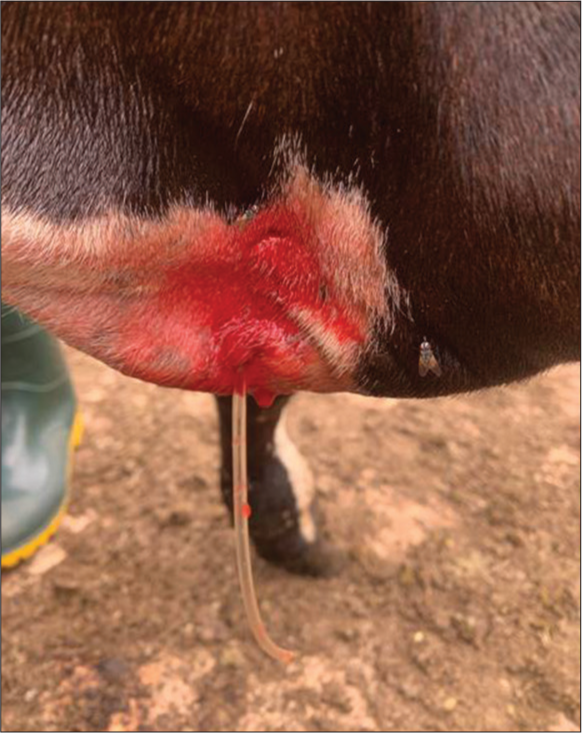Translate this page into:
A Case of Snake Bite in a One-Year-Old Cross-Breed Cow – A Case Report

*Corresponding author: Kingsley Chineto Anyika, Livestock Investigation Division, Department of Veterinary Medicine, National Veterinary Research Institute, Jos, Plateau, Nigeria. chinetoanyika@gmail.com
-
Received: ,
Accepted: ,
How to cite this article: Anyika KC, Govwang F, Omoniwa DO, Adah EJ. A Case of Snake Bite in a One-Year-Old Cross-breed Cow – A Case Report. Res Vet Sci Med. 2024;4:5. doi: 10.25259/RVSM_8_2024
Abstract
This clinical article reports a case of snake bite in a -year-old Friesian and white Fulani cross-breed cow at the Livestock Investigation Division of the National Veterinary Research Institute, Vom, Nigeria. The clinical signs observed during the physical examination are as follows: swollen brisket region and left forelimbs, anorexia, fever (39.2°C), and difficulty walking. The whole blood clotting time was positive (Absence of clotting for more than 2 h). The affected cow was treated using antibiotics, diuretics, and anti-inflammatory agents without the administration of anti-venom. The recovery was uneventful within 3 days following treatment.
Keywords
Cattle
Snake bite
Whole blood clotting time
Nigeria
INTRODUCTION
Snake bites are well-known veterinary emergencies in many parts of the world, especially the rural areas.[1] In Africa, snake bite is an important and common cause of sudden death in livestock, especially venomous snake.[2] Three snake species: carpet viper (Echis ocellatus), black-necked spitting cobra (Naja nigricollis), and puff adder (Bitis arietans) belonging to the Viperidae and Elapidae families are the most important snakes associated with envenomation in Nigeria.[2] Snake bites in large animals are usually inflicted on the feet, dewlaps, and limbs, especially the forelimbs, this happens usually while the animals are grazing.[2] The symptoms of snake bite vary according to the species of the biting snake and the quantity of venom deposited.[3] Clinical signs after snakebite may be local and/or systemic, which may include local swelling, which spreads in the surrounding area, redness, pain, lymphangitis and lymphadenitis, and anorexia.[3,4] Systemic symptoms may occur with gastrointestinal symptoms, hypotension, shock, circulatory and cardiac dysfunction, and respiratory, and nervous system dysfunction.[5,6]
There is a paucity of information on the management of snake bite cases in livestock in Nigeria. In this paper, we aim to report the successful management of a snake bite case in a 1-year-old cross-breed cow.
CASE REPORT
On the June 20, 2024, a 1-year-old Friesian and White Fulani cross-breed cow with swollen dewlap and left fore-limb was reported to the veterinary health section of Livestock Investigation Division, of the National Veterinary Research Institute, Vom, Nigeria, by a staff of the farm. History revealed that the animal was apparently well the previous day during grazing. The herd is managed under a semi-intensive system, where animals are taken out for grazing in the grass pasture paddocks during the day and returned to animal pens in the evening and fed a concentrated diet.
Clinical examination findings
On physical examination of the affected cow, the temperature was 39.2°C, pulse rate 105 beats/min, and respiratory rate 38 cycles/min. The following clinical signs were observed: swollen brisket region and forelimb with an accumulation of fluid [Figure 1], congested ocular mucous membrane, and difficulty walking. Two milliliters (2 mL) of blood was collected using a sterile 18G needle and syringe for Whole blood clotting time (WBCT). The blood sample was placed in a glass test tube and was observed for clothing by gentle agitation intermittently. There was no blood clotting observed after 2 h, indicating the absence of coagulopathy. The snake bite case was, therefore, diagnosed based on case history and clinical findings.

- Swollen brisket region of affected cow.
Case management
The edematous fluid was drained using a sterile 18G needle and 20 mL syringe. The swollen area was lanced with a sterile scalpel blade, and a temporary catheter was placed to facilitate continuous draining of the fluid [Figure 2]. The animal was placed on dexamethasone 0.02 mg/kg intramuscularly once; penicillin-streptomycin at 200 mg/kg intramuscularly for 3 days; and furosemide at 20 mg/kg I.M. once, following manufacturers direction.

- Temporary catheter at the wound site.
Following treatment, the animal had an uneventful recovery. The fluid drained completely within 3 days of the onset of treatment, and the swelling reduced.
DISCUSSION
There is a paucity of information on the management of snake bite cases in livestock, especially cattle in Nigeria. Large animals such as horses and cattle seldom die as a result of snake bites, perhaps due to their large sizes as compared to dogs and cats; however, deaths may occur following bites on the muzzle, and head when dyspnea occurs due to excessive swelling.[7] The diagnosis of snake bite was made based on history and clinical signs WBCT. There have been several reports of snakebite cases on the institute farm, especially during the rainy season. The cow had a swollen dewlap and forelimbs, and there were clinical signs of a systemic reaction, for example, fever and anorexia, which is consistent with signs of moderate envenomation according to reports by poisoning severity score.[1,6] The fang marks were not found, this may be due to the hair of the animal, which makes it difficult to identify fang marks in cattle. This finding is similar to a report by Ježek et al.[8] who also reported the absence of fang marks on the affected cow. Dexamethasone was administered to manage inflammation. Similarly, penicillin-streptomycin was administered for the control of secondary bacterial infection, which may arise due to the wound site. A temporary catheter was attached to facilitate the continuous draining of the fluid after administration of furosemide.
CONCLUSION
The diagnosis of snake bite was made based on case history, clinical signs, and WBCT. The affected animal was successfully treated without the administration of anti-venom as this was not readily available. The affected animal recovered within 3 days of treatment.
Ethical approval
The Institutional Review Board approval is not required.
Declaration of patient consent
Patient’s consent not required as there are no patients in this study.
Conflicts of interest
There are no conflicts of interest.
Use of artificial intelligence (AI)-assisted technology for manuscript preparation
The authors confirm that there was no use of artificial intelligence (AI)-assisted technology for assisting in the writing or editing of the manuscript and no images were manipulated using AI.
Financial support and sponsorship
Nil.
References
- European Snakes In: Brent J, Wallace KL, Burkhart KK, Phillips SD, Donovan JW, eds. Critical Care Toxicology: Diagnosis and Management of Critically Poisoned Patient. Philadelphia, PA: Elsevier Mosby; 2005. p. :1097-102.
- [Google Scholar]
- Venomous Snakes and Snake Envenomation in Nigeria In: Gopalakrishnakone P, Faiz A, Fernando R, Gnanathasan C, Habib A, Yang CC, eds. Clinical Toxinology in Asia Pacific and Africa. Toxinology Series. Vol 2. Dordrecht: Springer; 2005.
- [Google Scholar]
- Clinical and Biochemical Changes in 53 Swedish Dogs Bitten by the European Adder-Vipera berus. Acta Vet Scand. 2010;52:26-36.
- [CrossRef] [Google Scholar]
- Terrestrial Zootoxins In: Gupta RC, ed. Veterinary Tooxicology: Basic and Clinical Principles (2nd ed). New York: Elsevier; 2012. p. :984. Ch. 73
- [CrossRef] [Google Scholar]






